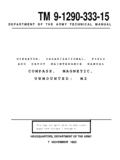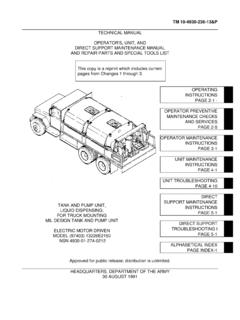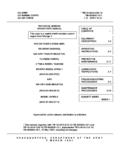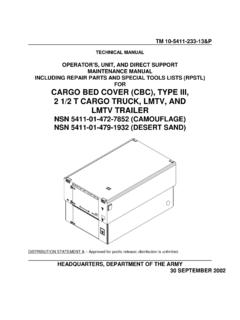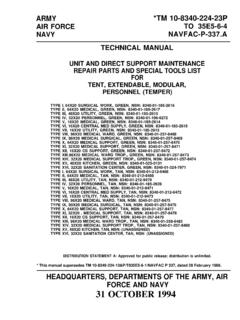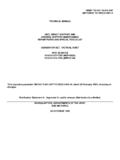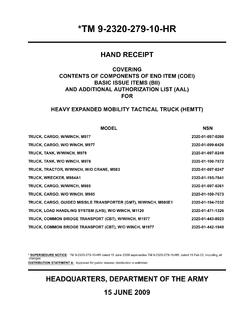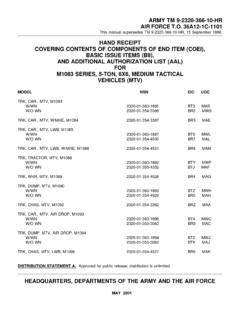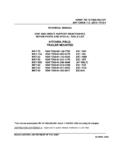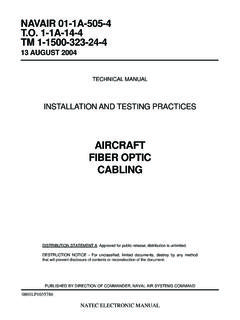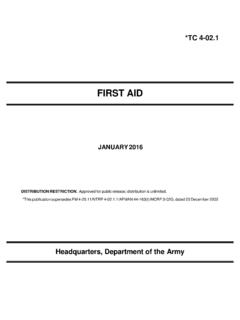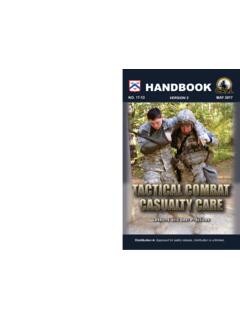Transcription of TECHNICAL MANUAL OPERATOR’S MANUAL SINCGARS …
1 TM 11-5820-890-10-8 HEADQUARTERS, DEPARTMENT OF THE ARMY 1 DECEMBER 1998 TECHNICAL MANUAL operator S MANUAL SINCGARS ground icom combat NET RADIOS AN/PRC-119A (NSN 5820-01-267-9482) (EIC: L2Q) AN/PRC-119D (NSN 5820-01-421-0801) (EIC: GC9) AN/PRC-119F (NSN 5820-01-451-8252) (EIC: GA4) AN/VRC-87A (NSN 5820-01-267-9480) (EIC: L22) AN/VRC-87C (NSN 5820-01-304-2045) (EIC: GDC) AN/VRC-87D (NSN 5820-01-351-5259) (EIC: GAR) AN/VRC-87F (NSN 5820-01-451-8248) (EIC: GA5) AN/VRC-87G (NSN 5820-01-555-7674) (EIC.)
2 N/A) AN/VRC-88A (NSN 5820-01-267-9481) (EIC: L23) AN/VRC-88D (NSN 5820-01-352-1694) (EIC: GAS) AN/VRC-88F (NSN 5820-01-452-8435) (EIC: GA3) AN/VRC-89A (NSN 5820-01-267-9479) (EIC: L24) AN/VRC-89D (NSN 5820-01-420-6619) (EIC: GD8) AN/VRC-89F (NSN 5820-01-451-8247) (EIC: GAY) AN/VRC-90A (NSN 5820-01-268-5105) (EIC: L25) AN/VRC-90D (NSN 5820-01-420-6618) (EIC: GD9) AN/VRC-90F (NSN 5820-01-451-8246) (EIC: GA2) AN/VRC-90G (NSN 5820-01-555-7371) (EIC.
3 N/A) AN/VRC-91A (NSN 5820-01-267-9478) (EIC: L26) AN/VRC-91D (NSN 5820-01-420-6621) (EIC: GDG) AN/VRC-91F (NSN 5820-01-451-8249) (EIC: GA8) AN/VRC-92A (NSN 5820-01-267-9477) (EIC: L27) AN/VRC-92D (NSN 5820-01-421-2605) (EIC: GDH) AN/VRC-92F (NSN 5820-01-451-8250) (EIC: GM2) USED WITH AUTOMATED NET CONTROL DEVICE (ANCD) AN/CYZ-10 SIMPLE KEY LOADER (SKL) AN/PYQ-10 PRECISION LIGHTWEIGHT GPS RECEIVER (PLGR) AN/PSN-11 SECURE TELEPHONE UNIT (STU) FREQUENCY HOPPING MULTIPLEXER (FHMUX) TD-1456/VRC APPROVED FOR PUBLIC RELEASE; DISTRIBUTION IS UNLIMITED.
4 TM 11-5820-890-10-8 Change 1 a SAFETY STEPS TO FOLLOW IF SOMEONE IS THE VICTIM OF ELECTRICAL NOT TRY TO PULL OR GRAB THE POSSIBLE, TURN OFF THE ELECTRICAL YOU CANNOT TURN OFF THE ELECTRICAL POWER,PULL, PUSH, OR LIFT THE PERSON TO SAFETY USING A DRY WOODEN POLE OR A DRY ROPEOR SOME OTHER INSULATING MATERIAL. SEND FOR HELP AS SOON AS THE INJURED PERSON IS FREE OF CONTACT WITH THE SOURCE OF ELECTRICAL SHOCK, MOVE THE PERSON A SHORT DISTANCE AWAY ANDIMMEDIATELY START ARTIFICIAL 5 1 2 4 5 3 TM 11-5820-890-10-8 b Change 1 WARNING LITHIUM NON-RECHARGEABLE BATTERIES Lithium Non-Rechargeable Batteries contain a great deal of energy.
5 They must never be charged or abused. Attempting to do so could result in leakage, fire or even an explosion. Lithium-Sulfur Dioxide (Li-SO2) batteries, such as BA-5590, contain a toxic, pressurized, and liquefied gas. It has a strong pungent odor. Lithium-Manganese Dioxide (Li-MnO2) batteries such as BA-5372 (HUB or Hold-Up battery) and BA-5390 contain a flammable electrolyte. Both types of batteries contain pure Lithium which reacts violently with water. DO NOT heat, incinerate, short circuit, puncture, mutilate or attempt to disassemble any battery.
6 DO NOT USE any battery which shows signs of damage, such as bulging, swelling, disfigurement, leaking or staining inside the plastic packaging. Keep all batteries in their original packaging until ready for use. DO NOT test Lithium batteries for capacity with a test set. No external test set exists that provides a reliable result. DO NOT store batteries in unused equipment for more than 30 days. If a battery compartment becomes hot to the touch, if it hisses or makes a burping sound, or if you smell irritating pungent Sulfur Dioxide gas: Turn off the equipment immediately and clear the area.
7 Let the equipment cool for at least an hour. After the equipment is cool and the odor has cleared, remove the battery or batteries. Install new battery or batteries and resume operation. If the equipment again becomes hot to the touch, go through the above steps but do not install new batteries. Turn in the equipment for maintenance. DO NOT place Lithium batteries in ordinary trash; turn them in for disposal in accordance with local regulations. DO NOT store Lithium batteries with other hazardous materials and keep them away from open flame or heat.
8 DO NOT use water to fight a Lithium battery fire. This is an extremely intense fire frequently characterized by a bright red flame. Carbon Dioxide or dry chemical fire extinguishers are effective in fighting fires of other combustibles and in keeping the batteries cool when exposed to fires in the vicinity. Sprinklers are recommended for storage areas to douse fires of other combustible materials and to keep batteries cool. NEVER use a Halon type fire extinguisher on a Lithium battery fire. This will only increase the intensity of the fire.
9 In the event of a Lithium fire, immediately EVACUATE THE AREA and contact the appropriate emergency authorities. Class D fire extinguishers are to be used only by professional fire fighters. WARNING RECHARGEABLE BATTERIES This includes BB-390/U Nickel-Metal Hydride (Ni-MH) and BB-2590/U Lithium-Ion (Li-Ion) batteries. DO NOT leave batteries in equipment for long term storage (more than 30 days). Charge batteries in long term storage at least annually, and charge them before inserting in equipment.
10 Before opening original packaging always examine the package for signs of leakage, staining or other indications of battery damage. DO NOT use a damaged battery. Always charge a rechargeable battery on the appropriate charger according to the dictates of the manufacturer. NEVER disassemble, heat, burn, or incinerate these or any batteries. CO2 or Dry Chemical fire extinguishers are suggested for fires involving these batteries. Turn in batteries for disposal. Dispose of them in accordance with local regulations.
